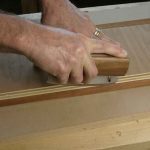We may receive a commission when you use our affiliate links. However, this does not impact our recommendations.
In this part I will talk about how we chose a new finish for Sharon's piece.
His piece, an old sideboard whose finish was in reasonable shape, needed a rejuvenating agent (one or two coats of clear finish) but did not require a complete stripping and refinishing.
Sharon asked me what kind of clear coat I think his cabinet was originally finished with. He was wondering if it was shellac or something else, and asked: "in the case that the furniture was finished with shellac – can I apply on it a wipe-on varnish?" The quick answer is yes. But, with some reservations.
First, I suggested that we try to find out what was the original finish. I recommended that he rub a hidden area of the old finish with a piece of cloth moistened with alcohol. In this situation, if the finish reacts to the alcohol and becomes sticky, then most likely it is shellac. If it does not react to alcohol, try the same technique but this time moisten the rag with acetone or lacquer thinner. If the finish reacts to lacquer thinner than it is most likely a lacquer. Now, if the finish does not react to alcohol nor to lacquer thinner, then it might have been finished with some sort of an oil, a varnish, or perhaps even polyester coating. In my experience, furniture made in Israel in the first half of the 20th century was, in most cases, finished with lacquer and only in a few cases with shellac. If I were restoring a valuable antique piece I would have used the same type of finish that was applied on it by the original maker. Wax on wax; oil on oil; shellac on shellac. But, also, in other cases where an old piece (not an antique) needs some touch ups and, most importantly, a new coat that will protect it from water and other liquid damages (shellac is not the most durable finish we know of) I would apply several coats of wipe-on varnish (varnish diluted with mineral spirit to enable an easy application). Sharon heeded my recommendation and decided to apply a wipe-on varnish. I gave him some tips how to do this:
1. Clean the old finish with alcohol or mineral spirit to remove any traces of oils, dirt and wax finish.
2. Sand the surfaces with 400 grit sand paper or (000) steel wool to make it easier for the new coat of finish to grab on.
3. Clean off the sand dust and apply the first coat , allowing it to cure for a day or two.
4. Buff the dry coat with (0000) steel wool, clean the steel wool dust and apply a second coat.
5. After the last coat has cured completely (a week) you can choose whether to buff it with (0000) steel wool in order to eliminate any traces of imperfect application technique, or leave it as is.
Nonetheless, before Sharon started refinishing we had to address yet another question: Can a modern varnish base finish be applied on a shellac finish? Here is the dilemma. Natural shellac contains a small amount of wax. It is very likely that the original woodworker who finished Sharon's piece (if he/she finished it with shellac) used shellac that was available at that time in Israel, and most likely this shellac was composed of at least a few percent wax. The presence of wax in shellac makes it difficult for the new top coats to adhere to it. Today, I said, we can easily buy de-waxed shellac and this finish accepts other kinds of finishes on top of it without any problem. But I have no idea if this was the case with the guy who finished Sharon's piece 70 or 80 years ago. It is theoretically possible that this person removed the wax from the mixture of shellac and alcohol that he made, but it is very unlikely. In any case, if we want to increase the chances of the new finish adhering to the old finish, we need to roughen up the surfaces to increase the mechanical grab of the new film, as it will have more surface to spread onto.
Sharon diluted varnish with 50% mineral spirit and applied the wipe-on varnish with a cotton cloth folded up.
Here are the pictures of the finished piece. I think it looks fantastic.


Here are some supplies and tools we find essential in our everyday work around the shop. We may receive a commission from sales referred by our links; however, we have carefully selected these products for their usefulness and quality.








